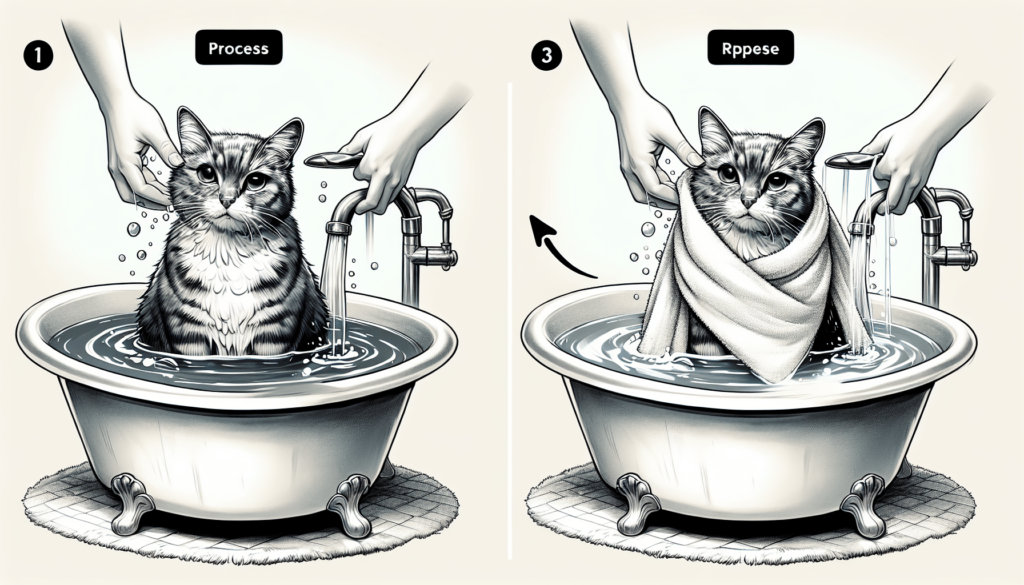Welcome! In this brief guide, you will learn how to give your feline friend a bath with ease. While many cats may not enjoy the experience, following these simple tips and tricks will help ensure a successful and stress-free bath time for both you and your kitty. From preparing the bath area to choosing the right shampoo, you’ll be equipped with everything you need to make bath time a breeze for your cat. Let’s get started on making bath time a positive experience for you and your furry friend! Have you ever wondered how to give a cat a bath? While most cats are known for grooming themselves, there may be times when a bath is necessary. Whether your feline friend got into something dirty or it’s necessary for their health, knowing how to properly bathe a cat is essential. In this article, we will guide you through the process of giving your cat a bath in a friendly and informative manner.
Preparing for the Bath
Before diving into the bath itself, it’s important to make sure you have everything you need to ensure a smooth bathing experience for your cat.
First, gather all necessary supplies:
- Shampoo specifically made for cats
- Towels
- A gentle brush
- A cup or small bucket
- Rubber mat or towel for the bottom of the sink or tub
- Treats for positive reinforcement
Make sure to choose a shampoo that is specifically formulated for cats to avoid irritating their skin. Additionally, have towels ready to dry your cat off quickly after the bath. A gentle brush can help remove any loose fur and tangles before the bath. Set up a rubber mat or towel in the sink or tub to provide your cat with traction, helping them feel more secure. Finally, have some treats on hand to reward your cat for good behavior during the bath.
Creating a Calm Environment
Creating a relaxed atmosphere can make a big difference in how your cat responds to bath time.
Start by choosing a quiet time of day when your cat is typically calm. Play soothing music or white noise to drown out any loud noises that may startle your cat. Keep the bathroom warm to prevent your cat from getting cold during the bath. Speak softly and reassure your cat throughout the process to help keep them calm.
Getting Your Cat Used to Water
Many cats are not fans of water, so it’s essential to introduce them to the idea of bathing gradually.
The Sink Method
One way to get your cat used to water is by using the sink method.
- Fill the sink with a few inches of lukewarm water
- Gently place your cat in the sink and let them explore
- Use a cup to pour water over your cat’s back, avoiding the face
- Give your cat treats or praise to reward positive behavior
The sink method allows your cat to become familiar with the sensation of water without the stress of a full bath. Start with short sessions and gradually increase the time as your cat becomes more comfortable.
The Wet Cloth Method
Another way to acclimate your cat to water is by using a wet cloth.
- Dampen a washcloth with lukewarm water
- Gently stroke your cat with the damp cloth
- Reward your cat with treats or praise for staying calm
This gentle method allows your cat to experience the feeling of water without the need for a full bath. It can help build their tolerance for wetness and make the bathing process easier in the future.

Bathing Your Cat
When it comes time for the actual bath, following the right steps can help ensure a successful experience for both you and your cat.
Step 1: Prep Your Cat
Before placing your cat in the water, take a few moments to prepare them.
- Brush your cat’s fur to remove any tangles or loose hair
- Apply a small amount of cat shampoo to your hands and lather it gently
- Speak softly to your cat and reassure them throughout the process
By taking the time to properly prep your cat, you can help make the bathing experience more comfortable for them.
Step 2: Getting Wet
Once your cat is prepped, it’s time to get them wet.
- Gently place your cat in the warm water, supporting their body
- Use a cup to pour water over your cat’s back, avoiding their face
- Gradually wet your cat’s fur, making sure to avoid their ears and eyes
Slowly introducing your cat to the water and keeping them calm can help prevent them from becoming anxious during the bath.
Step 3: Shampooing Your Cat
When it’s time to shampoo your cat, follow these steps.
- Apply a small amount of shampoo to your hands and lather it gently through your cat’s fur
- Be careful around your cat’s face, ears, and eyes
- Gently massage the shampoo into your cat’s fur, focusing on any dirty or oily areas
Make sure to choose a gentle cat shampoo and avoid using human or dog shampoo, as these can be too harsh for your cat’s skin.
Step 4: Rinsing Your Cat
After shampooing, it’s crucial to rinse your cat thoroughly to remove all traces of shampoo.
- Use a cup to pour lukewarm water over your cat’s fur, starting at the neck and working your way down
- Repeat the rinsing process until all shampoo is washed out
- Be thorough to prevent any skin irritation from leftover shampoo
Proper rinsing is essential to prevent skin irritation and ensure your cat’s coat is clean and shiny.
Step 5: Drying Your Cat
Once your cat is clean, it’s time to dry them off.
- Use a soft towel to gently pat your cat dry, avoiding any vigorous rubbing
- If your cat tolerates it, you can use a blow dryer set on low heat to speed up the drying process
- Make sure your cat is completely dry before allowing them to groom themselves
Drying your cat quickly and thoroughly can help prevent them from getting chilled and ensure their comfort after the bath.
Post-Bath Care
After your cat’s bath, it’s essential to provide them with comfort and care as they recover from the experience.
Handling Anxiety
Some cats may experience anxiety or stress after a bath.
- Create a cozy space for your cat to relax in, with their favorite blankets or toys
- Offer treats or playtime to help distract your cat and reduce anxiety
- Provide gentle petting and reassurance to help calm your cat
Allowing your cat to decompress after a bath can help them feel safe and secure as they recover.
Grooming
Once your cat is dry, they may need some help with grooming.
- Use a gentle brush to remove any tangles or mats in your cat’s fur
- Check your cat’s ears and eyes for any excess moisture or debris
- Allow your cat to groom themselves naturally to restore their coat’s oils
Regular grooming after a bath can help keep your cat’s fur healthy and prevent matting or tangling.
Monitoring Health
It’s essential to keep an eye on your cat’s health after a bath.
- Watch for any signs of skin irritation, such as redness or itching
- Check for any unusual behavior, such as excessive licking or grooming
- Contact your veterinarian if you notice any concerning symptoms
Monitoring your cat’s health after a bath can help catch any potential issues early and ensure they receive the care they need.

Conclusion
Giving your cat a bath may seem like a daunting task, but with the right preparation and approach, it can be a manageable experience for both you and your feline friend. By creating a calm environment, introducing your cat to water gradually, and following the proper bathing steps, you can ensure a successful bath for your cat. Remember to provide post-bath care, such as handling anxiety, grooming, and monitoring your cat’s health, to ensure they recover comfortably. With practice and patience, giving your cat a bath can become an essential part of their grooming routine.

